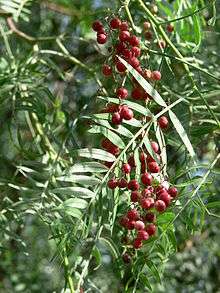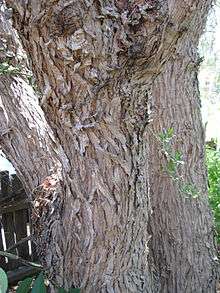Schinus molle
Schinus molle (Peruvian pepper, also known as American pepper, Peruvian peppertree, escobilla, false pepper, molle del Peru, pepper tree,[3] peppercorn tree, California pepper tree, pirul (in Mexican Spanish site)[4], Peruvian mastic[5], Anacahuita[6] and pepperina[7]) is an evergreen tree that grows to 15 meters (50 feet). It is native to the Peruvian Andes. The bright pink fruits of Schinus molle are often sold as "pink peppercorns" although S. molle is unrelated to true pepper (Piper nigrum). The word molle in Schinus molle comes from mulli,[8] the Quechua word for the tree. The tree is host to the pepper-tree moth, Bombycomorpha bifascia.
| Schinus molle | |
|---|---|
 | |
| Scientific classification | |
| Kingdom: | Plantae |
| Clade: | Tracheophytes |
| Clade: | Angiosperms |
| Clade: | Eudicots |
| Clade: | Rosids |
| Order: | Sapindales |
| Family: | Anacardiaceae |
| Genus: | Schinus |
| Species: | S. molle |
| Binomial name | |
| Schinus molle | |
Description
Schinus molle is a quick growing evergreen tree that grows up to 15 meters (50 feet) tall and wide.[5] It is the largest of all Schinus species and potentially the longest lived.[9] The upper branches of the tree tend to droop.[5] The tree's pinnately compound leaves measure 8–25 cm long × 4–9 cm wide and are made up of 19-41 alternate leaflets.[5][9] Male and female flowers occur on separate plants (dioecious).[5] Flowers are small, white and borne profusely in panicles at the ends of the drooping branches.[9] The fruit are 5–7 mm diameter round drupes with woody seeds that turn from green to red, pink or purplish,[5] carried in dense clusters of hundreds of berries that can be present year round.[9] The rough grayish bark is twisted and drips sap.[5] The bark, leaves and berries are aromatic when crushed.[5]
Distribution
Schinus molle is native to the arid zone of northern South America and Peru's Andean deserts, and goes to central Argentina and central Chile.[5] It has, however, become widely naturalized around the world where it has been planted, known for its strong wood used for saddles. It was part of the Spanish colonies' supply sources for saddles; as an ornamental and for spice production.[10] S. molle is a drought-tolerant, long-lived, hardy evergreen species that has become a serious invasive weed internationally.[10]
In South Africa, for example, S. molle has invaded savanna and grasslands and become naturalized along drainage lines and roadsides in semi-desert.[10] It is also invasive throughout much of Australia in a range of habitats from grasslands to dry open forest and coastal areas, as well as railway sidings and abandoned farms.[5] In the United States, either S. molle or its close relative Schinus terebinthifolius is particularly invasive in Florida and Hawaii, and can also be found crowding out native vegetation in southern Arizona, southern California, Texas, Louisiana and Puerto Rico.[11]

Uses
Culinary
Although not related to commercial pepper (Piper nigrum)[5] the pink/red berries are sold as pink peppercorns and often blended with commercial pepper.[5] The fruit and leaves are, however, potentially poisonous to poultry, pigs and possibly calves.[5] Records also exist of young children who have experienced vomiting and diarrhea after eating the fruit.[5] Presently Schinus molle lacks generally recognized as safe (GRAS) status with the United States Food and Drug Administration.[12]
Extracts of S. molle have been used as a flavor in drinks and syrups.[13]
Medicinal
In traditional medicine, S. molle was used in treating a variety of wounds and infections due to its antibacterial and antiseptic properties.[13] It has also been used as an antidepressant and diuretic, and for toothache, rheumatism and menstrual disorders,[13] with recent studies in mice providing possible support for its antidepressant effects.[14][15] It has also been speculated that S. molle's insecticidal properties make it a good candidate for use as an alternative to synthetic chemicals in pest control.[13]
Fresh green leaves in bunches are used shamanically in Mesoamerican traditional ceremonies for cleansings and blessings.
Other uses
The leaves are also used for the natural dyeing of textiles in the Andean region. This practice dates back to pre-Columbian times. The Incas used the oil from its leaves in early mummification practices to preserve and embalm their dead.[16]
Historical Use
The Inca used the sweet outer part of ripe fruit to make a drink. Berries were rubbed carefully to avoid mixing with the bitter inner parts, the mix strained and then left for a few days to produce a drink. It was also boiled down for syrup or mixed with maize to make nourishing gruel.[17]
There is also significant archaeological evidence that the fruits of S. molle were used extensively in the central Andes around 550-1000 AD for producing chicha, a fermented alcoholic beverage.[9]
Cultivation
The tree reproduces through seed, suckers and cuttings.[5] The seeds have a particularly hard coat and germination rates are greatly improved after they have passed through the gut of birds or other animals.[5] Seeds germinate in spring, with seedlings slow growing until established.[5] The seeds easily germinate under the tree in the existing leaf litter of the mother tree, by the hundreds at once and can be easily transplanted.
References
- "Schinus molle". Germplasm Resources Information Network (GRIN). Agricultural Research Service (ARS), United States Department of Agriculture (USDA). Retrieved 2008-07-06.
- Linnaeus, C. (1753), Species Plantarum 1: 388
- PLANTS Profile: Schinus molle L. (Peruvian peppertree), United States Department of Agriculture, retrieved 2008-07-06 (Archived by WebCite)
- «Pirul», en el sitio del Programa Ambiental de la Universidad Autónoma de la Ciudad de México. Consultado el 21 de junio de 2011.
- Blood, Kate (2001), Environmental weeds: a field guide for SE Australia, Mount Waverley, Victoria, Australia: CH Jerram, pp. 36–37, ISBN 0-9579086-0-1
- "Aguaribay, Árbol de la vida [Schinus molle] - Hora 25 Forestal". periodicohora25forestal.blogspot.com. Retrieved 2019-12-29.
- Poisonous plants> Shrub-tree> Pepperina (Schinus molle), Queensland Government: Children's Health Queensland Hospital and Health Service, retrieved 2019-07-17
- Diccionario Quechua - Español - Quechua, Academía Mayor de la Lengua Quechua, Gobierno Regional Cusco, Cusco 2005 (Quechua_Spanish dictionary)
- Goldstein, David John; Coleman, Robin Christine (2004), "Schinus molle L. (Anacardiaceae) Chicha production in the Central Andes", Economic Botany, New York, USA: Springer New York (published December 2004), 58 (4): 523–529, doi:10.1663/0013-0001(2004)058[0523:SMLACP]2.0.CO;2
- Iponga, D.M.; Milton, S.J.; Richardson, D.M. (2008), "Superiority in competition for light: A crucial attribute defining the impact of the invasive alien tree Schinus molle (Anacardiaceae) in South African savanna", Journal of Arid Environments (published May 2008), 72 (5), pp. 612–623, doi:10.1016/j.jaridenv.2007.10.001
- Elfers, S.C. (1988), Element Stewardship Abstract for Schinus terebinthifolius (PDF), Arlington, Virginia, United States: The Nature Conservancy (published 1988-10-13), archived from the original (PDF) on 2007-02-21
- Singh, Ram J.; Lebeda, Ales; Tucker, Arthur O. (2011). "2. Medicinal Plants—Nature's Pharmacy". In Singh, Ram J. (ed.). Genetic Resources, Chromosome Engineering, and Crop Improvement: Medicinal Plants. 6. CRC Press (published 15 September 2011). p. 17. ISBN 978-1420073843.
- Ferreroa, Adriana; Alejandra, Minettib; Cristina, Brasa; Zanettia, Noelia (2007), "Acute and subacute toxicity evaluation of ethanolic extract from fruits of Schinus molle in rats", Journal of Ethnopharmacology (published 2007-09-25), 113 (3), pp. 441–447, doi:10.1016/j.jep.2007.06.019, PMID 17716846
- Machadoa, Daniele G.; Kastera, Manuella P.; Binfaréa, Ricardo W.; Diasc, Munique; Santosb, Adair R.S.; Pizzolattic, Moacir G.; Brighentec, Inês M.C.; Rodrigues, Ana Lúcia S. (2007), "Antidepressant-like effect of the extract from leaves of Schinus molle L. in mice: Evidence for the involvement of the monoaminergic system", Progress in Neuro-Psychopharmacology and Biological Psychiatry, Elsevier (published 2007-03-30), 31 (2): 421–428, doi:10.1016/j.pnpbp.2006.11.004, PMID 17182164
- Daniele G. Machado, Luis E.B. Bettio, Mauricio P. Cunha, Adair R.S. Santos, Moacir G. Pizzolatti, Inês M.C. Brighente, and Ana Lúcia S. Rodrigues (2008). "Antidepressant-like effect of rutin isolated from the ethanolic extract from Schinus molle L. in mice: Evidence for the involvement of the serotonergic and noradrenergic systems." Eur. J' Pharmacol. 587 163-168.
- Adorno, Rolena; boserup, ivan (Dec 4, 2015). Unlocking the Doors to the Worlds of Guaman Poma and His Nueva corónica. Museum Tusculanum Press. p. 118. ISBN 9788763542708.
- Coe, Sophie D. (1994), America's first cuisines, University of Texas Press, pp. 186–187, ISBN 0-292-71159-X